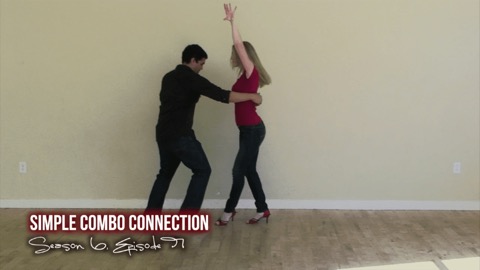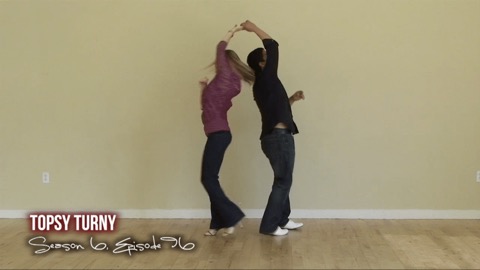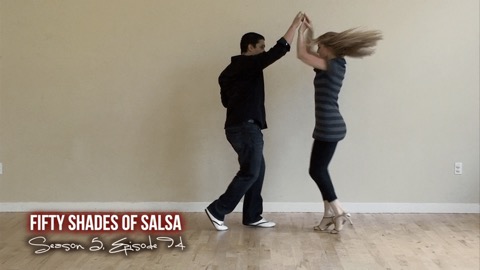Quick Salsa Styling Tips for Ladies
If anyone out there is wondering, "what can I do to improve that doesn't involve the natural process of getting good over time," I have some answers for you. Using body language (one of the main ways people communicate), you can improve how you look when you dance simply by remembering these easy tips. Look at it this way…for dancers who are taking classes or doing what they can to improve their dancing over time, these tips will help you look good while you are in the process of learning. Often, when a dancer is learning something new, the basics are thrown out the window. What ends up happening is that the body language suffers, so while you may have a great new footwork pattern, you've sacrificed some important basics. While you learn, keep these tips in mind, and you'll always look great!
Chin Up
The saying, "chin up" is popular for a reason! With your chin down you come across as self-conscious or sad, hence describing personalities as generally "down" or "up." When dancers learn something new or lack confidence in what they are doing, the chin tends to go straight down subconsciously. By reminding yourself to keep your chin up every once in a while, you will give off the perception that you are confident and happy with the dance. An additional benefit is that keeping your chin up enables you to literally "look up to" your partner as you dance, which will be understood as a sign of respect.
Shoulders Back
With any of these tips, thinking of the opposite provides an instant reason for why the tip looks good. In this case, the opposite would be hunched shoulders, which again signifies a lack of confidence, but this time is more a lack of confidence in your body and in what you can make it do. Since salsa dancing involves the shoulders and chest in many ways (e.g., chest pops, shimmies, shoulder rolls), keeping your shoulders back and your chest out is also the default position from which you start these movements. For this reason, most good dancers are always in "ready" position, so that they are balanced in in form to start the next move. Given that good dancers usually keep their shoulders back, and that beginning dancers usually do not, this is a tip that can help you cross that line (especially when you want someone to ask you to dance). Plus, good posture is generally thought to be more attractive
Arm & Hand Style
One of the easiest ways to annoy a leader is to hang on him. When in closed position (partners together), followers should rest their arms on the leaders shoulder and in the leaders hand very lightly. We want to give the impression of being united, but we should remain in the same position if the leader steps away (if you fall over or stumble, then it means you are resting too much). Not only does this help with not annoying the lead, but it also makes it much easier for the lead to take you through the moves because you are ready to go. Once your arms are in a nice, resting position, you can focus on your left hand that rests on his shoulder. How should it look? This depends on your preferred style, but there are lots of options rather than letting it just sit there. I use the "finger-egg" hand style, as I demonstrate in the video. This is just a simple thing you can do that looks pretty, so why not?
Knees Flexed
A common complaint of beginning dancers is feeling too rigid or stiff. Most of this comes with practicing different types of body movements and isolations, but there is a simple trick that can make you look more fluid right away. Simply keeping your knees flexed and staying on the balls of your feet can completely change how you move by making your steps look smooth and allowing more room for hip movement. On the contrary, if you stay flat-footed you may lose your balance from depending on the heel, move more slowly (one vs. two points of contact with the floor), and look "tired" or "robotic (see Anthony's demo in the video)". If your knees are locked, you may also lose your balance since you have no shock absorber and you will be slower to initiate movement, which may feel "heavy" to the leader. Again, this is about always being in "ready position" to be able to follow more easily. Aside from the benefits to your dancing, keeping your knees flexed and staying on the balls of your feet also just makes you look better (the hip action helps).
Smile!
This may not be a skill that separates dancers of different levels, but it definitely separates dancers with different attitudes! Whether you messed up, your partner, someone stepped on you or bumped into you, if you don't brush it off with a smile, the rest of the dance could be uncomfortable or even miserable. ESPECIALLY if your partner did something wrong and genuinely feels bad about it, smile and encourage the partner, and things will be much better. Going back to body language, people who do NOT smile come across with a variety of emotions: bored, angry, irritated, nervous…so if you don't let your partner know how you feel, they may just assume you are one of the above unpleasant temperaments. Practice this by watching others at the club and trying to read their emotions - see what you think looks good and what does not, and adopt that for yourself. Remember, dancing is an artistic expression using the body, including expressions of the face.











